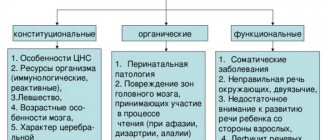Echolalia is the automatic repetition of other people's words, phrases, sentences, and even large parts of texts in speech.
In the process of individual development, there is a stage when echolalia in children is the norm - up to 2 years. At this age, the child actively imitates the behavior of adults (this is a mechanism of healthy mental development). From 6 to 9 months, one can also distinguish a period of normal autoecholalia - this is the time when the child himself repeats babbling syllables (ba-ba-ba, ma-ma-ma). Often parents mistake these autoecholalia for the first words.
If echolalia persists after 2-2.5 years, it is a symptom of a developmental disorder. And there is a stereotype that echolalia is a symptom of autism. This is wrong.
Echolalia can occur with various disorders (and even in adults, by the way):
- ZRR, ZPRR;
- Sensory alalia (dysphasia);
- Mental retardation;
- Schizophrenia;
- Autism spectrum disorder;
- Tourette's syndrome.
Echolalia occurs:
- Immediate
- Deferred.
Often, a child with delayed echolalia can perfectly insert phrases from cartoons and songs into the context of the situation. Good mechanical memory may be a kind of compensatory mechanism.
For me, as a specialist, a diagnosis is always of a secondary nature (especially since I do not make them; sometimes a diagnosis is a tribute to one or another administrative requirements of the system). It is much more important to understand the mechanism of the disorder, find out what and where “broke” and how the brain tries to get around it.
What is echolalia?
People with echolalia repeat sounds and phrases they hear. They cannot communicate effectively because they have difficulty expressing their own thoughts. For example, a person with echolalia may repeat a question rather than answer it. In many cases, echolalia is an attempt to communicate, learn, or practice language.
Echolalia is different from Tourette's syndrome, where the speaker may suddenly scream or say random things. In this case, the speaker has no control over what he says or when he says it.
Repetitive speech is an extremely common part of language development and is commonly seen in young children learning to communicate. By age 2, most children begin to mix their own utterances with repeating what they hear. By age 3, most children's echolalia is minimal.
It is common for children with autism or developmental delays to have echolalia during childhood, especially if they experience language delays. Determining why and how your child uses echolalia will help you develop a treatment plan. Consulting a speech therapist or language psychologist may help.
Self-stimulating behavior
Delayed echolalia is sometimes a self-stimulating behavior whose sole purpose is the pleasure of the speaker. My eldest son always likes to repeat sentences he read in books. I realized that he sees the book in his head, and simply entertains himself by “rereading” his favorite passages over and over again. The line "George, what's that smell?" clearly borrowed from the book about the skunk "Curious George", which invariably causes homeric laughter.
He also enjoys repeating clips from his favorite videos as if he were watching them in his head. When delayed echolalia is used as personal entertainment, it can interfere with real communication. An adult can use such echolalia as a hint to gently switch the child to a more constructive activity.
Causes and risk factors
All children experience echolalia when they first begin to learn spoken language. Most of them develop independent thinking as they age, but some continue to repeat what they hear. Children with communication disorders hang on to repeated expressions much longer. Children with autism are especially susceptible to echolalia.
Some people only experience this problem when they are worried or anxious. Others experience it constantly, which can eventually lead to muteness as they are unable to express themselves.
Adults with severe amnesia or head trauma may experience echolalia when trying to regain their speech abilities.
Types of echolalia
There are two main categories of echolalia: functional (or interactive) echolalia and non-interactive echolalia, where sounds or words may only be used for personal use and not communication.
Interactive echolalia
Functional echolalia is an interactive communication attempt designed to interact with another person. For example:
- A person with echolalia uses phrases to fill gaps in alternating verbal exchanges.
- Speech is used to complete familiar verbal procedures initiated by others. For example, if a person with echolalia is asked to complete a task, they may say “good job!” in the process of execution, repeating what he is used to hearing.
- Speech can be used to offer new information, but it can be difficult to connect the dots. For example, a mother might ask her child what he wants for lunch and he will sing the song from the commercial about wanting a sandwich.
- A person with echolalia may say “do you want lunch?” to ask for their own lunch.
Non-interactive echolalia
Non-interactive echolalia is generally not intended for communication, but rather for personal use, such as personal reference or self-stimulation. Examples include:
- Unfocused speech . A person with echolalia may say things that are not relevant to the context of the situation, such as saying parts of a TV show while walking around the classroom. This behavior can be self-stimulating.
- Situational association . Speech is triggered by a situation, image, person, or activity and does not appear to be an attempt at communication. For example, if someone sees a branded product in a store, they might sing the song from the commercial.
- Rehearsal . The speaker may say the same phrase to himself softly several times before responding in a normal voice. This can be practice for upcoming interactions.
- Self-instruction . People can use statements to guide themselves through the process. For example, if they are making a sandwich, they might say to themselves, “Turn on the water. Use soap. Wash your hands. Turn off the water. Hands are dry. Take some bread. Place the bread on a plate. Take the sausage,” and so on until the process is completed.
What activities does a child with ASD and sensory alalia need?
It is important to remember that independent work of a parent with a child is not a substitute for specialized speech therapy correction. If the specific manifestations described above occur, you must contact a neurologist and speech therapist. The neurologist will conduct the necessary set of diagnostic studies, and the speech therapist will determine the nature of the speech disorder and draw up a corrective route.
On average, the duration of speech therapy work with children with sensory alalia varies between 1-2 years. Corrective assistance for a child with autism spectrum disorder continues throughout schooling.
What determines the duration of correction of a speech disorder? Firstly, on the severity of speech pathology, secondly, on the systematics of attending correctional classes and, thirdly, on the availability of comprehensive assistance from correctional specialists. Comprehensive care, as a rule, includes sessions with a speech therapist, sessions with a speech pathologist, sessions with a psychologist and long-term observation by a neurologist tracking the dynamics of elimination of speech disorders.
It is you who can become your child’s guide to a completely new world - a world of instructions that he understands, mother’s kind words and father’s kind praise.
Interactive and non-interactive echolalia: what is the difference
Echolalia reflects how the speaker processes information. It can be difficult to tell the difference between interactive and non-interactive echolalia until you get to know the speaker and how they communicate. In some cases, echolalia seems completely out of context.
Let's consider this example. If a child with echolalia gets angry with his teacher after recess, he may suddenly say, “Go to hell, Lieutenant!” The teacher will later discover that the child watched A Few Good Men and used an anger-related phrase to convey his feelings at that moment. Although his answer seemed out of context, he had a reason to use this phrase to communicate.
How to use echolalia to develop ready-made speech patterns with the personal pronoun I
Many speech pathologists and psychologists focus on the “speaking on behalf of the child” , which is especially effective for children with ASD at the first stage of the onset of echolalia.
In essence, you must voice the child’s desires and descriptions of reality from HIS PERSON - providing him with ready-made phrases for REPEAT (!) in common everyday circumstances.
For example, to begin with, accompany all actions of self-service and description of the current moment with Self-constructs:
- What are you doing? - I am eating. I go on the road. I walk with my feet. I'm swimming. I'm taking a bath. I'm getting dressed. I put socks on my feet. I put my shoes back. I wash my hands.
Also accompany with I-constructions all moments when it is especially important for the child to quickly learn to explain his feelings and desires:
- The child is capricious. You suggest: “Explain in words: what do you want?” - I'm tired. I want to rest. I want to eat. I want to sleep. I'm thirsty. I want to be held in your arms. I want to go on the swing.
Gradually, you can include in the list of self-constructs your assumptions about the emotions that the child obviously experiences:
- Dad came home from work - “I’m glad dad.”
- You and your baby found a toy while playing hide and seek - “I’m glad for the doll.”
- The child is looking for his grandmother in the rooms after her visit - “Where is grandma? I miss my grandmother."
- A child is afraid of a dog on the street - “I’m afraid of a dog.”
- The child hugs his mother tightly after seeing her again at the end of the day at kindergarten - “I love you / I love mommy.”
It is YOU who say these words: “I am eating”, “I want to be held”, etc. According to the experience of many specialists and the theory of speech formation in children with ASD, at these moments the child remembers wording according to circumstances and emotions. They are recorded in memory, from which speech can then be formed in ASD - albeit not in the most usual ways and paces.
Treatment
Echolalia can be treated using a combination of the following methods:
Speech therapy
Some people with echolalia attend regular speech therapy sessions to learn how to express themselves.
A behavioral intervention called cue-pause-dot is often used for intermediate echolalia. In this treatment, the speech therapist asks the person with echolalia to answer a question correctly and tells them that they will tell them when to answer. The therapist then asks a question such as “what is your name?” and after a short pause invites the speaker to answer. He also holds a card with the correct answer.
Drug treatment
Your doctor may prescribe antidepressants or anxiety medications to combat the side effects of echolalia. This does not apply to the condition itself, but it does help keep the person with echolalia calm. Because the symptoms of echolalia can worsen when a person is stressed or anxious, the calming effect can help reduce the severity of the condition.
Home care
People with echolalia can work with others at home to develop their communication skills. There are text-based and online curriculum programs that can help parents get positive feedback from their children. Encouraging your child to use limited vocabulary will help him communicate more effectively.
Diagnostics
Long-term persistence of vocabulary and syllabic speech imitation in childhood or the appearance of this symptom in adults requires contacting a psychiatrist and neurologist. Echolalia is diagnosed during communication with the patient and observation of his speech. Typically, identifying automated repetitions of sentences and words is not difficult. To establish the nature of echolalic symptoms, a comprehensive examination is performed:
- Assessment of psychoneurological status.
Anamnesis collection, a clinical conversation, and a neurological examination allow doctors to assess the patient’s general condition: his ability to establish and maintain contact, navigate in space and time, and think critically about his illness. Neurological disorders and psychopathological symptoms accompanying echolalia are detected. - Speech therapy testing.
The speech therapist examines the speech function, determines the degree of its formation, the presence of pronunciation defects, and the loss of individual links. In conclusion, he notes whether echolalia is the result of speech underdevelopment or speech decay. - Pathopsychological testing.
A study of memory, thinking, attention and intelligence is carried out. The results indicate the presence or absence of signs of organic damage to the central nervous system, intellectual underdevelopment as the cause of echolalic manifestations. - Neuropsychological testing.
Diagnostics by a neuropsychologist is aimed at analyzing higher mental functions. Testing data allows us to determine neuropsychological symptoms (various types of alalia, aphasia) and differentiate neurological diseases.
Echolalia: prospects and prevention
Echolalia is a natural part of language development. Trying to remove it completely is not always a good idea. To avoid persistent echolalia in children, parents should encourage other forms of communication. Introduce your child to a wide variety of words and phrases. Over time, most children will be able to overcome their echolalia naturally.
Sources:
Impulse follows strict sourcing guidelines and relies on peer-reviewed studies, research institutions and medical associations. We avoid using insufficiently expert links.
- Heffner, G. J. (n.d.). Echolalia - repetitive speech autism-help.org/communication-echolalia-autism.htm
- Neely, L., Gerow, S., Rispoli, S., Lang, R., Pullen, N. (2016, March). Treatment of echolalia in individuals with autism spectrum disorder: A systematic review. Review Journal of Autism and Developmental Disorders, 3(1) link.springer.com/article/10.1007/s40489-015-0067-4
- Stokes, S. (n.d.). Increasing expressive skills for verbal children with autism. Retrieved from cesa7.org/sped/autism/verbal/verbal11.html
- Vicker, B. (2009). Functional categories of immediate echolalia iidc.indiana.edu/?pageId=535
- What is tourette? (n.d.) tourette.org/about-tourette/overview/what-is-tourette/








